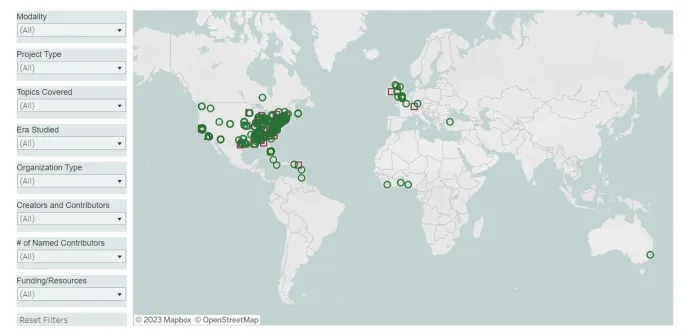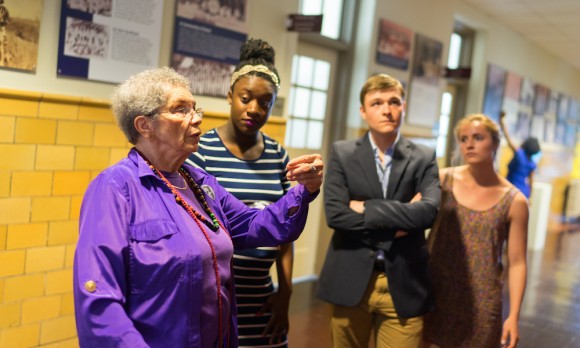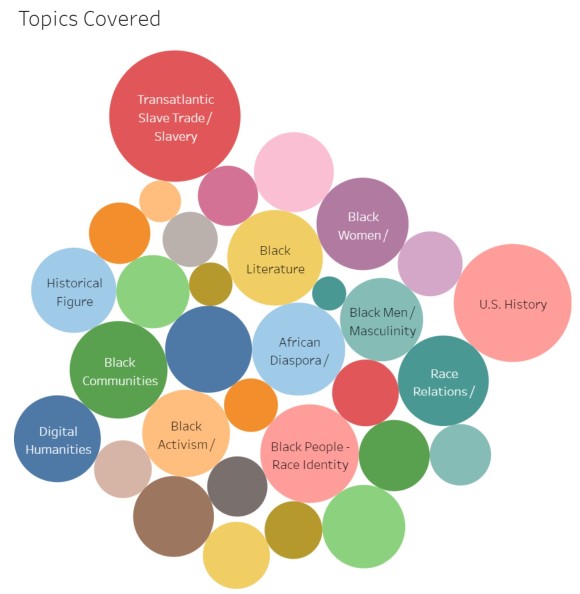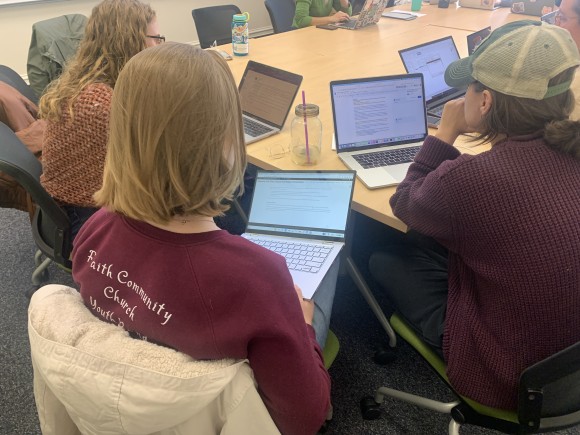Black DH in Public: Mapping the Black Digital and Public Humanities

The map on Mapping the Black Digital Humanities, as of September 2023. Image from sites.lib.jmu.edu/mappingbdph.
James Madison University’s Mapping the Black Digital and Public Humanities project is an interdisciplinary, interactive, and searchable map of digital and public humanities projects related to Black history and culture. Launched in the Spring of 2023 by a team of faculty, library professionals, and graduate students based at JMU, the goals of the project are threefold: first, to help people find digital and public projects about Black history and culture by topic, type, location, contributors, and more; second, to make it easier to see and build connections or networks across similar projects; and third, to enable deeper analyses of the Black Digital Humanities and Black Public Humanities as fields, including making it easier to locate gaps and identify potential interventions for growth.
Our team’s work on this project has been shaped by many questions. Since 2015, several of us have been working on a project in rural Virginia that celebrates the importance of education to the Black community in Harrisonburg, VA and surrounding counties. Like many projects of its kind, Celebrating Simms comprises countless collaborators and supporters, including local residents and government officials; high school, undergraduate, and graduate students; teachers, professors, and social studies coordinators; library professionals; archivists; designers; administrators; and local and regional granting agencies across the state. This project and those relationships represent a profound joy for us. They also bring a deep sense of responsibility, and sometimes even worry: How do we keep this all going? Will we get that grant we applied for? How can we compensate or at least properly acknowledge the many, many hours poured into the project by our colleagues, students, and community partners? How do we let people beyond our local community know about the importance, value, and even existence of this work? Is it different doing this kind of work in big cities? At other types of universities, institutions, or community organizations?
How do projects elsewhere do it all? Where are they? What if we were better connected?

Existing resources such as the Colored Convention Project’s Black Digital Humanities Projects and Resources Google Doc and the Reviews in Digital Humanities journal’s project registry have been tremendously useful in answering some of these questions. We embarked on this project with a sense of deep admiration and indebtedness to these and other existing projects that document and uplift the field. We were also excited about how our experience working on a local historical recovery project might help us contribute to these conversations in useful ways. For example, since location is so important to our Celebrating Simms project, we were inspired by work such as Alex Gil’s Around DH in 80 Days to wonder what might be revealed by mapping the locations of other Black digital and public humanities projects. We were also excited by developments in data visualization software with mapping capabilities such as Tableau, which could enable us not only to locate projects geographically, but also to compile detailed information about them and offer users various ways to sort, view, and interact with project place markers—for example, by topic covered, era studies, project type, funding type, organization type, and more.

Over the course of about a year, we brought together JMU faculty, graduate students, and our longtime Celebrating Simms collaborators at JMU Libraries to embark upon this data-gathering, mapping, and visualization adventure with us. Together, we researched and collected data on nearly 450 Black digital humanities and public projects in the field and began experimenting with and refining our categorization of and configurations for presenting this data. We also reached out to all of these projects’ directors to confirm their project information and their consent to be included on the map, all while adjusting components of the project in response to their feedback and adding new projects to the map as submissions rolled in.

We are currently expanding our JMU-based leadership team to include broader disciplinary and geographical expertise, and together our growing team is beginning to plan the project’s next stage of development. In its current form, the map is very skewed toward projects based in the U.S., and our first next step is to research, reach out to, and include more projects from elsewhere around the globe. To build community and collaboration networks, we are also exploring programming possibilities such as inviting experts to curate themed data visualizations and project lists, a publishing platform for blog posts and data analyses, live and teleconferenced events, and more. Finally, we want to explore further how we can develop our early experiments in visualization to better understand the scope, reach, and unmet needs of Black public and digital humanities projects worldwide.
As we’ve written about elsewhere, we understand mapping as a double operation that landscape architect James Corner calls “finding and founding”—one that entails both a recuperation of past work and a commitment to building new futures. We also understand mapping through the lens of Kimberlé Crenshaw’s definition of “mapping the margins,” as a kind of locating that makes different futures possible for the people in previously unseen locations. Mapping the Black Digital and Public Humanities aims to make more visible the incredible but sometimes unseen work that is already happening across these two rich, intersecting fields. As our work develops, our hope is to find new ways to communicate and collaborate across the networks that sustain but also sometimes fail to sustain these varied types of projects, and to build new networks better designed to keep local and lesser-known projects “on the map.”
Iliana Cosme-Brooks is a graduate student studying Writing, Rhetoric and Technical Communication at James Madison University. Her main research interests surround cultural institution writing, particularly holistic approaches that make museum spaces and information more equitable and accessible.
Mollie Godfrey is an associate professor of English and African, African American, and Diaspora Studies at James Madison University, with a Ph.D. in English from the University of Chicago. Her work has appeared in numerous scholarly journals, and she is the editor of two books, Neo-Passing: Performing Identity after Jim Crow (University of Illinois Press, 2018) and Conversations with Lorraine Hansberry (University Press of Mississippi, 2020). She is also co-director of several community-engaged Black archival recovery and digital humanities projects, including Celebrating Simms: The Story of the Lucy F. Simms School and the Furious Flower Archive: A Prototype.
Seán McCarthy is a professor in the School of Writing, Rhetoric and Technical Communication at James Madison University, where he also serves as director of the Cohen Center for the Humanities. Seán’s research explores the intersections between the interdisciplinary fields of writing studies, community engagement, and innovation studies. He is particularly interested in how to create sustainable and impactful transdisciplinary teaching and research cultures in higher education institutions.